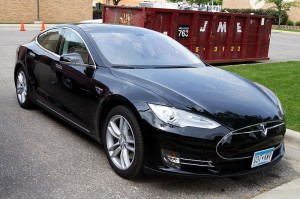 Tesla Motors founder and CEO Elon Musk has officially announced the name of their new all electric car in an interview with the UK-based car news site Auto Express: it is called Model III with “three bars to represent it”.
Tesla Motors founder and CEO Elon Musk has officially announced the name of their new all electric car in an interview with the UK-based car news site Auto Express: it is called Model III with “three bars to represent it”.
Then Musk revealed details about the vehicle. It is set to debut in 2016 and to be on sale in 2017 competing directly with BMW 3 Series. The new vehicle will be the third generation after the Model S sedan which is on sale right now and the Model X planned to be launched next year.
The Model 3 will be based on an all-new platform rather than a cut-down version of Model S and Model X. The new technology is an idea of Tesla’s engineering chief Chris Porritt who used to work with Aston Martin.
The new model will be Tesla’s most affordable car so far at just $35,000 with a range of approximately 200 miles per charge. The size of the new vehicle is reportedly to be 20% smaller than the Model S, a bit like the BMW 3 Series, according to Auto Express. The key to the Model 3 is cheaper batteries manufactured at Tesla’s future factory Gigafactory.
The factory is scheduled to open in 2020 and the cost to build it is around $5 billion. It is planned to achieve approximately 30% reduction in production costs for Tesla car batteries and it will have a capacity to supply 500,000 Tesla vehicles with batteries per year. They haven’t chosen the location for the factory yet but it will be in one of the four U.S. states: Arizona, Nevada, Texas or New Mexico.
It was also revealed that a range upgrade is planned for the original Roadster. It will get a modern battery with a range of about 400 miles on charge, “which will allow you to drive from LA to San Francisco non-stop”.
Besides, recently Tesla had to prove that its software systems are safe from nuisances like hackers. At a computer security conference that took place in Beijing last week on July 16, a small number of white-hat tech geeks had a chance to win $10,000. The organizers of the SyScan Conference set hackers a challenge: to break into a Model S computer system and manipulate the car’s controls remotely.
The team of Qihoo, a Chinese internet security company and one of the sponsors of the event, gained control of some Tesla Model S functions: the door locks, the horn and the headlights while the car was in motion. However, Qihoo refused to reveal how they had performed the hack.
Tesla wasn’t involved in the competition officially, but lessons learned at the conference could make electric cars even safer in the future. Given its models’ high-tech nature, it is not a surprise that the company takes security very seriously. Model S presently has the highest safety rating in the whole car market, boasting a five-star rating from the National Highway Safety Administration.